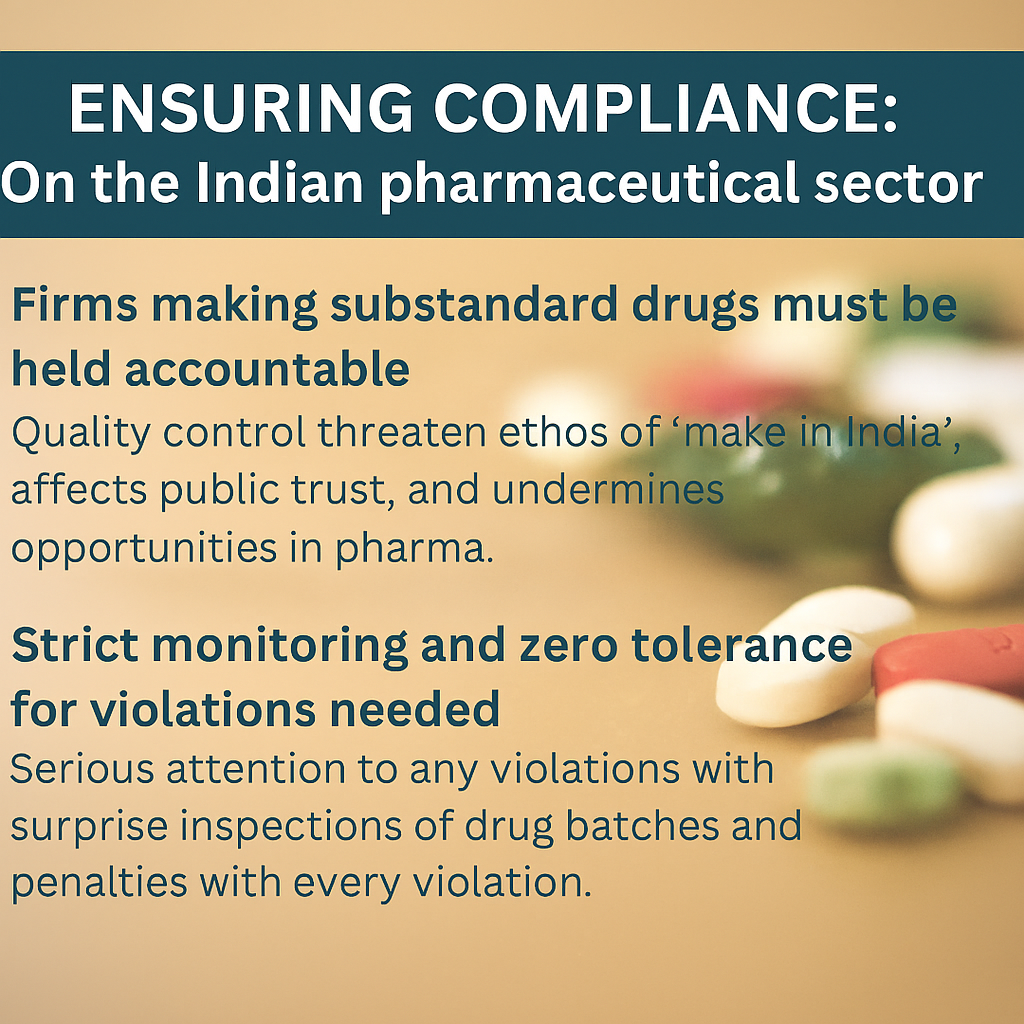A recent editorial, “Ensuring compliance: On the Indian pharmaceutical sector,” cuts to the heart of a crisis that is both a national shame and a grave public health emergency. The piece, triggered by the tragic deaths of at least 16 children linked to contaminated cough syrup, is more than just a report on a single failure. It’s a powerful indictment of a systemic rot and a desperate plea for the soul of an industry India is proud to call its own.
Let’s break down the key arguments and read between the lines of this crucial editorial.
The Immediate Tragedy: A Case Study in Failure
The editorial begins with a specific, heartbreaking case. The cough syrup “Coldrif” was found to contain diethylene glycol (DEG), a toxic substance used in antifreeze, which led to the deaths of children in Rajasthan and Madhya Pradesh. This incident alone is a catastrophe. But the editorial highlights several alarming details that point to a much larger problem:
- Inconsistent Test Results: The Union Health Ministry initially ruled out DEG, while the Tamil Nadu Drugs Control Department found it in their samples. This discrepancy isn’t just a bureaucratic mix-up; it erodes public trust and raises serious questions about the uniformity and rigor of drug testing across different state and central agencies.
- The Root Cause was Predictable and Preventable: The Tamil Nadu report didn’t find a mysterious, unknown contaminant. It found that the manufacturer used “non-pharmacopoeial grade propylene glycol.” In simple terms, they cheaped out. They used a low-quality, industrial-grade chemical instead of the mandated, pure, medical-grade one to save costs. This is not an accident; it’s a conscious, criminal decision where profit was prioritized over human life.
- Systemic Non-Compliance: The violations weren’t limited to one ingredient. The manufacturing facility was found flouting Good Manufacturing Practices (GMP) and Good Laboratory Practices (GLP). This suggests a culture of negligence was pervasive throughout the production process.
The Bigger Picture: “Atmanirbhar Bharat” at Risk
The editorial brilliantly frames this failure not just as a health issue, but as an economic and reputational one. It connects the dots between these isolated incidents and India’s global ambitions.
- The Aspiration vs. The Reality: The government’s “Atmanirbhar Bharat” (Self-Reliant India) campaign is an aspirational goal. But as the editorial states, this ideal “is not worth pursuing without a sustained quality control framework.” A “Made in India” label must be a synonym for trust and quality, not suspicion and danger.
- Global Repercussions: India is rightly known as the “Pharmacy of the World,” supplying affordable generic medicines to countless nations. However, a string of such quality failures—the editorial mentions that the issue of cough syrups has been “repeatedly raised”—threatens to destroy this hard-earned reputation. International regulators could impose bans and stricter inspections, crippling a crucial export sector.
The Editorial’s Prescription: Beyond Token Actions
The piece rightly dismisses the government’s subsequent actions—license cancellations and arrests—as merely “good to address the situation in the instant case.” These are reactive measures. The editorial demands a proactive, systemic overhaul.
Here are its core recommendations, which are as insightful as they are urgent:
- Zero Tolerance Policy: The state must have a “zero threshold for poor quality drugs.” This means that any violation, no matter how small, should be met with swift and severe consequences. The mindset must shift from “acting after deaths occur” to “preventing deaths from ever happening.”
- “Hawk-like Monitoring”: This is a powerful metaphor. It calls for vigilant, sharp, and relentless surveillance. This cannot be a periodic, announced affair. It must involve regular, surprise inspections that keep manufacturers permanently on their toes.
- A Message to the Assembly Line: Perhaps the most crucial point is about deterrence. The government must “send the message down the assembly line” that corner-cutting will not be tolerated. Every worker, chemist, and manager must know that the consequences of shoddiness are career-ending and criminal.
The Human Cost: What the Editorial Implies
Reading this, one cannot ignore the profound human tragedy that underscores every word. The phrase “It is criminal to act only when deaths have occurred; that is indefensible” is a moral verdict. It reminds us that behind the jargon of “Schedule M norms” and “non-pharmacopoeial grade excipients” are children who suffered painful, preventable deaths. The arrest of a single doctor, while perhaps necessary, feels like a distraction from the primary culpability of the manufacturer.
Conclusion: A Crossroads for Indian Pharma
This editorial is a wake-up call that India can no longer afford to ignore. The path forward is clear:
- For the Government: Implement the revised Schedule M norms with unwavering strictness. Invest in strengthening the Central Drugs Standard Control Organisation (CDSCO) and state-level agencies with more manpower, advanced technology, and political backing to act fearlessly.
- For the Industry: The pharmaceutical industry must self-regulate with a conscience. Leading players should champion quality, understanding that the irresponsible actions of a few bad actors tarnish the entire sector.
- For the Public: We must become more vigilant, demand transparency, and hold both companies and regulators accountable.
The choice is stark. We can either build a “robust and trustworthy industry” that truly embodies the spirit of Atmanirbhar Bharat, or we can allow a lethal cocktail of negligence and greed to poison both our children and our nation’s future. The editorial leaves no doubt about which path we must choose
Editorial Credit Note
This analysis is based on the editorial titled “Ensuring compliance: On the Indian pharmaceutical sector” published by The Hindu on October 7, 2025. All rights to the original content, including headline, publication date, and editorial perspective, remain with The Hindu. This commentary is intended for educational and analytical purposes, with full acknowledgment of The Hindu as the original source. For the complete editorial, please refer to The Hindu’s official website.
